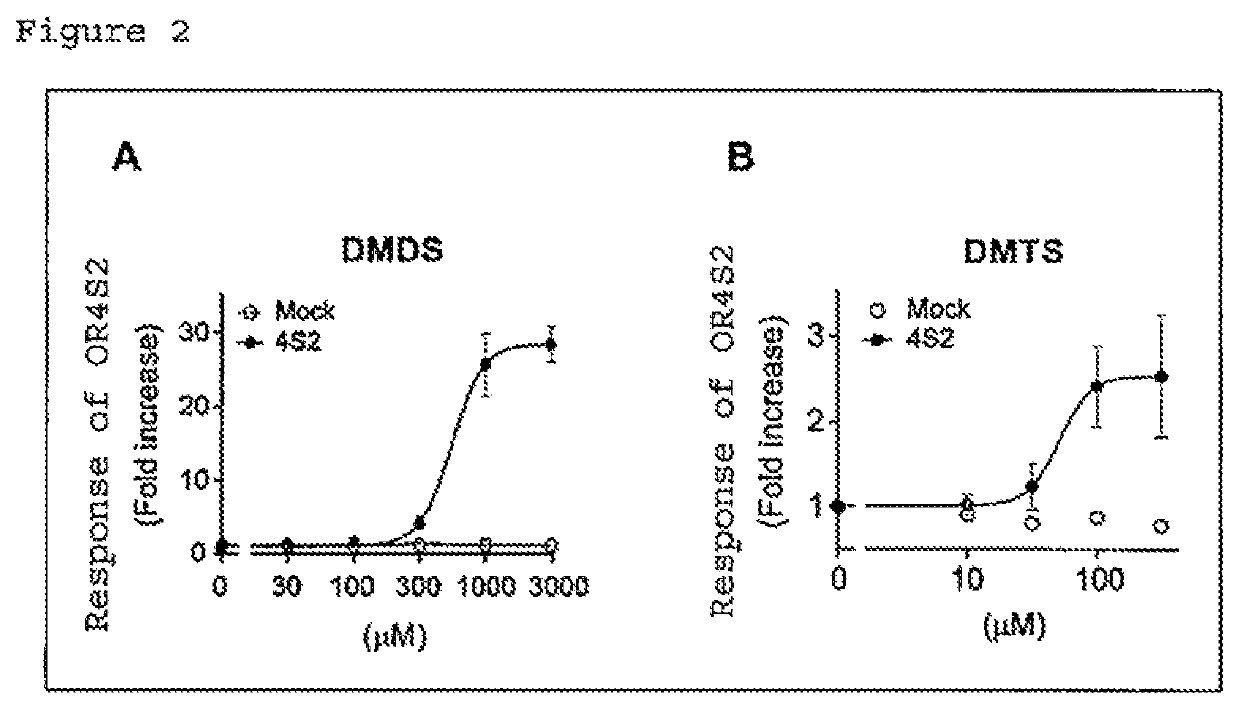Agent for suppressing odors of polysulfide compounds
a technology of polysulfide compound and odor suppressant, which is applied in the direction of disinfection, organic active ingredients, drug compositions, etc., can solve the problems of giving unpleasant feelings to people and no smell recognizabl
- Summary
- Abstract
- Description
- Claims
- Application Information
AI Technical Summary
Problems solved by technology
Method used
Image
Examples
example 1
ation of Olfactory Receptor Responsive to Polysulfide Compound
(1) Cloning of Human Olfactory Receptor Gene
[0093]A human olfactory receptor cloned using the PCR method with human genomic DNA female (G1521: Promega Corporation) as a template on the basis of sequence information registered in GenBank. Each gene amplified through the PCR method was incorporated into a pENTR vector (Invitrogen) in accordance with the manual, and recombined, by utilizing the NotI and AscI sites present in the pENTR vector, with a pME18S vector at the NotI and AscI sites produced in the downstream of the Flag-Rho tag sequence of the pME18S vector.
(2) Preparation of pME18S-human RTP1S Vector
[0094]A vector expressing receptor-transporting protein (RTP), a protein which promotes the expression of an olfactory receptor polypeptide on the cell membrane, was prepared. Specifically, a gene encoding human RTP1S (GI: 50234917) was incorporated into a pME18S vector at the EcoRI and XhoI sites thereof.
(3) Preparation...
example 2
for OR452: =Antagonist
[0100]By using the same procedure as in Example 1 (1) to (3), HEK293 cells expressing OR4S2 (SEQ ID NO: 1) were prepared. The response of the olfactory receptor to DMDS (the value fLuc / hRluc) was measured in the presence and absence of a test substance by using luciferase reporter gene assay in accordance with the procedure in Example 1 (4). The value fLuc / hRluc induced by a stimulus of single DMDS, (X), the value fLuc / hRluc for cells without a stimulus of DMDS, (Y), and the value fLuc / hRluc induced by a co-stimulus of DMDS and a test substance, (Z), were determined, and the intensity of the response (Response (%)) of the receptor to DMDS in the presence of a test substance was determined by using the following formula.
Response (%)=(Z−Y) / (X−Y)×100
The experiment s performed independently three times, and the average value of the experiments was determined. The concentration of DMDS to be added to a culture was set a 1 mM, and the concentration of a test substanc...
example 3
f OR4S2 Antagonists to Suppress Odors of Polysulfide Compounds
[0103]The odor-suppressing effect of each of trimethylhexyl aldehyde (THA), cis-4-heptenal, and 1,4-cineol, as the OR4S2 antagonists identified in Example 2, for polysulfide compounds was checked in a sensory test.
[0104]For each of DMDS, THA, cis-4-heptenal, and 1,4-cineol, a 0.1% (v / v) solution in mineral oil was prepared. For DMTS, a 0.01% (v / v) solution in mineral oil was prepared. Two cotton balls were put in 20 mL glass bottle (Maruemu Corporation, No. 6), and one cotton ball was impregnated with 30 μL of the DMDS or DMTS solution, and the other cotton ball was impregnated with 30 μL of a solution of one of the three OR4S2 antagonists. The glass bottle containing the cotton balls was covered with a lid, and left to stand at 37° C. for 1 hour, and thereafter used as a test sample for a sensory test. Glass bottles containing only cotton ball impregnated with the DMDS or DMTS solution were prepared as reference samples,...
PUM
| Property | Measurement | Unit |
|---|---|---|
| concentration | aaaaa | aaaaa |
| volatile | aaaaa | aaaaa |
| affinities | aaaaa | aaaaa |
Abstract
Description
Claims
Application Information
 Login to View More
Login to View More - R&D
- Intellectual Property
- Life Sciences
- Materials
- Tech Scout
- Unparalleled Data Quality
- Higher Quality Content
- 60% Fewer Hallucinations
Browse by: Latest US Patents, China's latest patents, Technical Efficacy Thesaurus, Application Domain, Technology Topic, Popular Technical Reports.
© 2025 PatSnap. All rights reserved.Legal|Privacy policy|Modern Slavery Act Transparency Statement|Sitemap|About US| Contact US: help@patsnap.com



